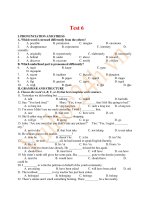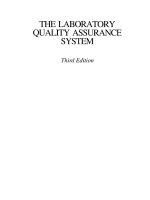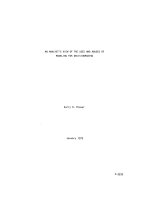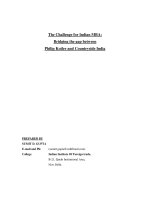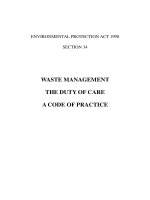The Weighted Airman Promotion System - Standardizing Test Scores potx
Bạn đang xem bản rút gọn của tài liệu. Xem và tải ngay bản đầy đủ của tài liệu tại đây (740.29 KB, 169 trang )
This document and trademark(s) contained herein are protected by law as indicated
in a notice appearing later in this work. This electronic representation of RAND
intellectual property is provided for non-commercial use only. Unauthorized
posting of RAND PDFs to a non-RAND Web site is prohibited. RAND PDFs are
protected under copyright law. Permission is required from RAND to reproduce,
or reuse in another form, any of our research documents for commercial use. For
information on reprint and linking permissions, please see RAND Permissions.
Limited Electronic Distribution Rights
Visit RAND at www.rand.org
Explore RAND Project AIR FORCE
View document details
For More Information
This PDF document was made available
from www.rand.org as a public service of
the RAND Corporation.
6
Jump down to document
THE ARTS
CHILD POLICY
CIVIL JUSTICE
EDUCATION
ENERGY AND ENVIRONMENT
HEALTH AND HEALTH CARE
INTERNATIONAL AFFAIRS
NATIONAL SECURITY
POPULATION AND AGING
PUBLIC SAFETY
SCIENCE AND TECHNOLOGY
SUBSTANCE ABUSE
TERRORISM AND
HOMELAND SECURITY
TRANSPORTATION AND
INFRASTRUCTURE
WORKFORCE AND WORKPLACE
The RAND Corporation is a nonprofit
research organization providing
objective analysis and effective
solutions that address the challenges
facing the public and private sectors
around the world.
Purchase this document
Browse Books & Publications
Make a charitable contribution
Support RAND
This product is part of the RAND Corporation monograph series.
RAND monographs present major research findings that address the
challenges facing the public and private sectors. All RAND mono-
graphs undergo rigorous peer review to ensure high standards for
research quality and objectivity.
Michael Schiefer, Albert A. Robbert, John S. Crown,
Thomas Manacapilli, Carolyn Wong
Prepared for the United States Air Force
Approved for public release; distribution unlimited
PROJECT AIR FORCE
The Weighted Airman
Promotion System
Standardizing Test Scores
The RAND Corporation is a nonprofit research organization providing
objective analysis and effective solutions that address the challenges
facing the public and private sectors around the world. RAND’s
publications do not necessarily reflect the opinions of its research clients
and sponsors.
R
®
is a registered trademark.
© Copyright 2008 RAND Corporation
All rights reserved. No part of this book may be reproduced in any
form by any electronic or mechanical means (including photocopying,
recording, or information storage and retrieval) without permission in
writing from RAND.
Published 2008 by the RAND Corporation
1776 Main Street, P.O. Box 2138, Santa Monica, CA 90407-2138
1200 South Hayes Street, Arlington, VA 22202-5050
4570 Fifth Avenue, Suite 600, Pittsburgh, PA 15213-2665
RAND URL:
To order RAND documents or to obtain additional information, contact
Distribution Services: Telephone: (310) 451-7002;
Fax: (310) 451-6915; Email:
The research described in this report was sponsored by the United States
Air Force under Contract FA7014-06-C-0001. Further information may
be obtained from the Strategic Planning Division, Directorate of Plans,
Hq USAF.
Library of Congress Cataloging-in-Publication Data
Is Available
iii
Preface
is study, conducted in the Manpower, Personnel, and Training Pro-
gram of RAND Project AIR FORCE (PAF), is a follow-on to Air Force
Enlisted Force Management: System Interactions and Synchronization
Strategies (Schiefer et al., 2007). is monograph explores a potential
modification to the enlisted promotion system, one of the primary sys-
tems that affect the enlisted force.
Brig Gen Glenn Spears sponsored this work in fiscal year 2006
as the Director of Force Management Policy, Deputy Chief of Staff
for Personnel, Headquarters U.S. Air Force. e research was accom-
plished as part of a project entitled Enlisted Force Management. is
monograph should be of interest to those responsible for Air Force
enlisted testing and promotion policies, to those who develop enlisted
promotion tests, to strength managers, to the Chief’s Group at the Air
Force Personnel Center, and to enlisted career field managers.
We appreciate that the findings in this monograph will not gener-
ate change without the support of key leaders within the Air Force. e
document was prepared with that audience in mind.
RAND Project Air Force
RAND Project AIR FORCE, a division of the RAND Corporation, is
the U.S. Air Force’s federally funded research and development center
for studies and analyses. PAF provides the Air Force with independent
analyses of policy alternatives affecting the development, employment,
combat readiness, and support of current and future aerospace forces.
iv The Weighted Airman Promotion System: Standardizing Test Scores
Research is conducted in four programs: Aerospace Force Develop-
ment; Manpower, Personnel, and Training; Resource Management;
and Strategy and Doctrine.
Additional information about PAF is available on our Web site:
/>v
Contents
Preface iii
Figures
ix
Tables
xiii
Summary
xv
Acknowledgments
xix
Abbreviations
xxi
CHAPTER ONE
Introduction 1
e Air Force Cannot Be Achieving Its Primary Enlisted Promotion
Objective
2
e Motivation for Enlisted Promotion Equity
4
e Air Force Has Not Achieved All TOPCAP and Secondary
Promotion Objectives
7
Organization of the Monograph
10
CHAPTER TWO
e Weighted Airman Promotion System: Motivation, Mechanics,
Reality, and eory
13
A Fundamental Relationship
17
Reality
18
eoretical Impacts of Differences in Variation
24
Measuring Variation
26
E5 WAPS Component Impacts
26
E6 WAPS Component Impacts
31
E7 WAPS Component Impacts
33
E8 WAPS Component Impacts 36
E9 WAPS Component Impacts
37
Chapter Summary
39
CHAPTER THREE
Standardizing Test Scores 41
What Is Test Standardization?
42
Why Standardize?
42
Approaches to Standardizing PFE/SKT Scores
43
Standardization Mechanics
44
An Alternative Approach to Standardization
46
Disclaimer
47
CHAPTER FOUR
Testing Impact and Selection Timing 49
Selections to E2–E4
49
Selections to E5
50
A Univariate Perspective of Selections to E5
52
A Multivariate Perspective of Selections to E5
54
Selections to E6
56
A Univariate Perspective of Selections to E6
57
A Multivariate Perspective of Selections to E6
58
Selections to E7
60
A Univariate Perspective of Selections to E7
61
A Multivariate Perspective of Selections to E7
63
Selections to E8
64
E8 Selection Factors
65
Selections to E9
67
Chapter Summary
68
CHAPTER FIVE
Effects 71
Inconsistent and Random Selection Standards
71
Senior NCO (E7–E9) Manning
72
Unequal Opportunities to Make E8 and E9
73
vi The Weighted Airman Promotion System: Standardizing Test Scores
Disproportionate Selectivity for E9 Nominative and Commander-
Involvement Positions
74
Standardization Strategies
76
Transition Issues
79
Standardization Costs
80
CHAPTER SIX
Conclusions and Recommendation 83
Conclusions
83
Recommendation
83
APPENDIXES
A. e Impact of WAPS Factors by Grade and AFSC 87
B. AFSC Titles
97
C. WAPS Changes over Time
101
D. Periodic WAPS Revalidation
105
E. Four Approaches to Measuring the Impacts of WAPS Factors
107
F. Multivariate Models to Predict Selection Rates to E5
113
G.
Multivariate Models to Predict Selection Rates to E6 125
H. Multivariate Models to Predict Selection Rates to E7
131
I. ACT, SAT, and ASVAB Approaches to Standardization
137
References
143
Contents vii
ix
Figures
1.1. Disparate Seniority Ratios, September 2006 8
1.2. Percentage of Chief Master Sergeants Within an AFSC
With 20 or Fewer Years of Service, September 2006
10
2.1. Distribution of EPR Scores on 05E7 for 2A5X1
19
2.2. Distribution of Decoration Scores on 05E7 for
AFSC 2A5X1
20
2.3. Distribution of Longevity Scores on 05E7 for
AFSC 2A5X1
21
2.4. Distribution of Testing Scores on 05E7 for
AFSC 2A5X1
22
2.5. Distribution of Testing Scores on 05E7 for
AFSCs 3E2X1 and 7S0X1
23
2.6. Distribution of AFQT Scores of 05E7 Testers for
AFSCs 3E2X1 and 7S0X1
23
2.7. WAPS Component Impacts, 05E5 Cycle
27
2.8. Within-AFSC Testing Impacts, E5 Cycles
28
2.9. Different Rates of Perfect EPR Awards
29
2.10. Testing Impact Versus Standard Deviation of Test Scores
29
2.11. Testing Impact Versus Standard Deviation in Test Scores
Divided by Standard Deviation in Total Score,
Cycle 98E5
30
2.12. WAPS Component Impacts, 05E6 Cycle
31
2.13. Within-AFSC Testing Impacts, E6 Cycles
32
2.14. Distribution of Years of Service, September 2005
33
2.15. WAPS Component Impacts, 05E7 Cycle
34
2.16. Distribution of Standard Deviations of Test and Total
Scores, 05E5 Cycle
35
x The Weighted Airman Promotion System: Standardizing Test Scores
2.17. Distribution of Standard Deviations of Test and Total
Scores, 05E6 Cycle
35
2.18. Distribution of Standard Deviations of Test and Total
Scores, 05E7 Cycle
36
2.19. Within-AFSC Testing Impact, E7 Cycles
37
2.20. WAPS Component Impacts, 05E8 Cycle
38
2.21. WAPS Component Impacts, 05E9 Cycle
38
3.1. Distributions of Raw SKT Scores for AFSC 3E2X1 and
7S0X1, Cycle 05E7
45
3.2. Distributions of Standardized SKT Scores for AFSCs 3E2X1
and 7S0X1,
S
s
=11, Cycle 05E7 45
3.3. Distributions of Standardized SKT Scores for AFSCs 3E2X1
and 7S0X1,
R
s
= 50,
S
s
= 11, Cycle 05E7 46
4.1. Selection Rates, Four Years TIS, Cycle 05E5
51
4.2. Selection Rate Versus Testing Impact, 05E5 Cycle, 20 AFSC
Moving Average
53
4.3. Selection Rate Versus Highest and Lowest Testing Impact,
05E5 Cycle
54
4.4. Selection Rate Versus Testing Impact, TIS=4, 05E5 Cycle
55
4.5. Selection Rate Versus Highest and Lowest Testing Impact,
05E5 Cycle
56
4.6. 05E6 Selection Rates, AFSCs with at Least 25 Eligibles
with TIS
≤ 7 57
4.7. Selection Rate Versus Testing Impact, 8, 10, 12, and 14
Years TIS, 05E6 Cycle, 20-AFSC Moving Average
58
4.8. Selection Rate Versus Highest and Lowest Testing Impact,
05E6 Cycle
59
4.9. Selection Rate Versus Testing Impact, 05E6 Cycle
59
4.10. Selection Rate Versus High and Low Testing Impact,
05E6 Cycle
60
4.11. 05E7 Selection Rates, AFSCs with at Least 25 Eligibles
with TIS Less an or Equal to 14
61
4.12. 05E7 Selection Rate Versus Testing Impact, 20-AFSC
Moving Average
62
4.13. 05E7 Selection Rate Versus Testing Impact, TIS Less
an or Equal to 15
63
4.14. Modeled Selection Rate Versus Testing Impact,
05E7 Cycle
64
4.15. E8 Selection Rates Versus Board Score Deciles
65
x
4.16. Top Board Scores Versus Time in Service 66
4.17. E9 Selection Rates Versus Board Score Deciles
67
4.18. E9 Board Scores in Top 20 Percent Versus TIS
68
5.1. Simulation Results
73
5.2. Phase Points to E7 for Strategic Chiefs
74
5.3. Date of Rank to E7 for Recent Strategic Chiefs
75
5.4. Average Phase Points to E7 by Fiscal Year
76
5.5. Relationship Between Standard Deviation of Test Scores
and Deep-Selected E9s
78
5.6. Potential Single-Cycle Impact of Standardization on
Individuals
79
C.1. Distribution of Selection Rates for 05E8 Cycle
103
C.2. 05E8 Selection Rates Versus September 30, 2005
Manning
104
E.1. Distribution of Testing Scores in Cycle 05E7 for
AFSCs 2A5X1 and 2E0X1
108
F.1. E5 Cycle Selection Rates
114
F.2. Normal and CCS Selection Rates, 98E5–05E5 Cycles
114
F.3. Trends in EPR and Longevity Standard Deviations,
98E5–05E5 Cycles
116
F.4. WAPS Factor Impacts, 98E5–05E5 Cycles
116
F.5. Perfect EPR Scores, 98E5–05E5 Cycles
117
F.6. Model Coefficients for 98–05 E5 Cycles
123
G.1. E6 Cycle Selection Rates
125
G.2. Model Coefficients, E6 Cycles
129
H.1. E7 Cycle Selection Rates
131
H.2. Regression Coefficients, 98E5–05E7 Cycles
135
Figures xi
xiii
Tables
2.1. Current WAPS Factors 16
2.2. YOS Distribution for E5s in AFSC 3P0X1 Who Became
E6s in FY06
18
4.1. Typical Phase Points to E2–E4
50
A.1. Average Impacts of WAPS Factors for 87 Stable AFSCs,
98–05 E5 Cycles
87
A.2. Average Impacts of WAPS Factors for 103 Stable AFSCs,
98–05 E6 Cycles
90
A.3. Average Impacts of WAPS Factors for 84 AFSCs, 98–05
E7 Cycles
93
B.1. AFSC Titles
97
C.1. WAPS as Implemented on January 2, 1970
101
C.2. Major Changes to WAPS
102
E.1. Standard Deviations of WAPS Components in Cycle
05E7 for AFSCs 2A5X1 and 2E0X1
108
E.2. Standard Deviations of WAPS Components Divided by
Standard Deviation of Total Scores in Cycle 05E7 for
AFSCs 2A5X1 and 2E0X1
109
E.3. Correlation Matrix in Cycle 05E7 for AFSC 2E0X1
109
E.4. Correlation Matrix in Cycle 05E7 for AFSC 2A5X1
110
E.5. Approach ree: Average Change in Rank Order
Percentile
111
E.6. Approach Four: Average Change in Standard Deviations
from the Mean
112
F.1. Eligible E4s by Time in Service
115
F.2. Candidate Predictor Variables
117
F.3. E5 Cycle Models
118
xiv The Weighted Airman Promotion System: Standardizing Test Scores
F.4. TIS = 4 Model 119
F.5. TIS = 4 Modeled Selection Rates for High/Low Testing
Impacts, Cycle 01E5
121
F.6. TIS = 7 Model
122
G.1. Distribution of E5s by Time in Service
126
G.2. Fast Burner Model
127
G.3. FB+7+8 Model
128
H.1. Distribution of Eligible E6s by Time in Service
132
H.2. TIS ≤14 Model
133
H.3. TIS ≥19 Model
134
xv
Summary
e U.S. Air Force has three major independent systems that affect
the health of its enlisted force: the manpower system, the strength
management system, and the enlisted promotion system. Because the
current organizational structure lacks broad coordinating and con-
trol mechanisms, this independence spawns policies and procedures
that occasionally work at cross-purposes. We discuss these systems at
length in Air Force Enlisted Force Management: System Interactions and
Synchronization Strategies (Schiefer et al., 2007). at monograph pro-
poses multiple follow-on efforts, and this study fulfills one of those
recommendations.
Specifically, we examine the practice of not standardizing the test
scores that are part of the enlisted promotion system.
1
is practice pro-
duces results that are inconsistent with two overarching policies. First,
Air Force Policy Directive 36-25 requires that the enlisted promotion
system “identify those people with the highest potential to fill positions
of increased grade and responsibility.”
2
We show that not standardizing
test scores means that the Air Force emphasizes longevity and testing
ability differently across and within specialties to identify individuals
1
Many, if not most, tests that are administered to different groups at different times are
standardized. Standardization involves mathematically transforming raw test scores into new
scores with desirable properties. For example, the Armed Forces Qualification Test (AFQT)
reports standardized scores, so that an AFQT score of 72 represents the same level of ability
today as it did four years ago. Were it not for standardized scores, the military services could
not track the quality of new recruits over time.
2
U.S. Air Force, 1993, p. 1.
xvi The Weighted Airman Promotion System: Standardizing Test Scores
with the highest potential. Further, we demonstrate that these stan-
dards vary randomly over time. Random variations in the impacts of
selection criteria make it difficult to understand how the Air Force can
be achieving its primary promotion policy objective.
Our second concern deals with differences in promotion oppor-
tunity. While the testing dimension of the enlisted promotion system
allows members to influence their own destinies, not standardiz-
ing scores means that members of specialties in which testing carries
more weight have more control than members of other specialties do.
is produces random promotion opportunity differences across Air
Force specialty codes (AFSCs), thus violating an equity principle that
can be traced to a 1970s-era strategic plan for enlisted force manage-
ment known as the Total Objective Plan for Career Airman Personnel
(TOPCAP).
3
Because the Air Force does not standardize test scores,
the current policy of equal selection opportunity does not imply equal
promotion opportunity over a career. Consequently, there is a greater
opportunity to achieve senior enlisted grades in some AFSCs than in
others.
e random aspects of the enlisted promotion system also pro-
duce other potentially undesirable consequences. For example, not
standardizing scores yields unpredictable manning percentages by spe-
cialty. is has negative force management implications. Uncertainty
also means that the Air Force, when it fills future strategic chief master
sergeant positions, will disproportionately draw from specialties in
which testing carries more weight.
4
e modification we propose would not change equal selec-
tion opportunity. However, it would affect selection decisions within
AFSCs. Test score standardization would primarily affect those com-
3
e Air Force Personnel Plan (U.S. Air Force, 1975) provides TOPCAP details. A pri-
mary objective of TOPCAP was to maintain a career force, and it established a promotion
system founded on equity across specialties. at culture of equity persists throughout the
enlisted force today, and subsequent personnel plans have consistently stressed the impor-
tance of equity. One premise of TOPCAP was that promotion equity and predictability were
keys to realizing retention rates that would sustain the career enlisted force.
4
e Air Force fills strategic chief positions through commander involvement or nomina-
tion processes.
Summary xvii
peting for selection to E5–E7. It would have extremely limited impacts
on E8 and E9 selections, which are determined primarily by selection
board scores.
After presenting supporting data, we discuss a range of outcomes
that the Air Force could achieve by adopting various standardization
strategies. We recommend that the Air Force leadership implement a
standardization strategy that will produce predictable outcomes that
are consistent with its personnel priorities and policies.
xix
Acknowledgments
We could not have initiated this work without the sponsorship of Brig
Gen Glenn Spears, who provided Project AIR FORCE with the oppor-
tunity to reengage in enlisted management issues. We thank John Park,
Tina Strickland, and Lisa Mills from the Deputy Chief of Staff for Per-
sonnel’s (AF/A1) Force Policy Management Division, Gwen Ruther-
ford from the Leadership Transformation and Integration Division,
and CMSgt Trenda Voegtle from the Promotion Policy Division for
their insights. CMSgt Rusty Nicholson, Ken Schwartz, and Johnny
Weissmuller at the Air Force Personnel Center generously shared their
knowledge of the enlisted promotion system.
We are also grateful to Lt Col Jim Wisnowski, Commander of
the Air Force Occupational Measurement Squadron. In addition, we
thank Julie Duminiak and Neil Dorans from the Educational Testing
Service (ETS) who directed us to ETS studies and responded to our
inquiries regarding ETS’s approach to standardization. We thank Jim
Sconing for his detailed explanations of standardization for the Ameri-
can College Test (ACT).
We thank our colleagues Harry ie and John Drew and Jay
Jacobson (Air Force retired) for their extremely constructive formal
reviews. Finally, we wish to acknowledge our editor, Miriam Polon.
xxi
Abbreviations
ACT American College Test
AF/A1 Air Force Deputy Chief of Staff for Manpower and
Personnel
AFI Air Force Instruction
AFQT Armed Forces Qualification Test
AFPC Air Force Personnel Center
AFPC/DPP AFPC Directorate of Personnel Programs
AFSC Air Force specialty code
ASVAB Armed Services Vocational Aptitude Battery
CAREERS Career Airman Reenlistment Reservation System
CCS chronic critical shortage
CJR career job reservation
DoD Department of Defense
DoDD Department of Defense Directive
E1 airman basic
E2 airman
E3 airman first class
E4 senior airman
E5 staff sergeant
E6 technical sergeant
E7 master sergeant
E8 senior master sergeant
E9 chief master sergeant
EPR enlisted performance report
xxii The Weighted Airman Promotion System: Standardizing Test Scores
ESO equal selection opportunity
ETS Educational Testing Service
FB fast burner
FY fiscal year
HYT high year of tenure
IDEAS AFPC’s Interactive Demographic Analysis System
IEB initial enlistment bonus
MAGE mechanical, administrative, general, electronic
NCO noncommissioned officer
NPS non–prior service
OSD Office of the Secretary of Defense
OSI Office of Special Investigations
PFE Promotion Fitness Exam
RAW Retrieval Application Website (AFPC)
ROTC Reserve Officer Training Corps
SAT Scholastic Aptitude Test
SECAF Secretary of the Air Force
SKT Specialty Knowledge Test
SRB selective reenlistment bonus
TIG time in grade
TIS time in service
TOPCAP Total Objective Plan for Career Airman Personnel
TPR trained personnel requirement
UIF unfavorable information file
WAPS Weighted Airman Promotion System
YOS years of service
1
CHAPTER ONE
Introduction
is monograph is an extension of Air Force Enlisted Force Manage-
ment: System Interactions and Synchronization Strategies (Schiefer et al.,
2007), which discusses policy options that the Air Force employs in
its efforts to manage the active-duty enlisted force. One of the main
messages of the earlier study is that enlisted strength managers need
to better synchronize the three primary control systems that affect the
health of the enlisted force:
the strength management system, which establishes targets for t
total strength, recruiting, retraining, and bonuses
the manpower system, which sets requirements for each grade and t
specialty combination in the form of authorizations
the enlisted promotion system, which determines the annual t
number of selections by grade in the aggregate and in each
specialty.
1
e Air Force currently tends to manage these systems in isola-
tion. However, actions taken to control one system often affect another.
For example, the earlier study postulated that the Air Force’s policy of
not standardizing the test scores that are part of the enlisted promo-
tion system might be having adverse impacts on the strength manage-
1
In this monograph, aggregate means all specialties considered as a group. Disaggregate
means at the Air Force specialty code (AFSC) level of detail.

